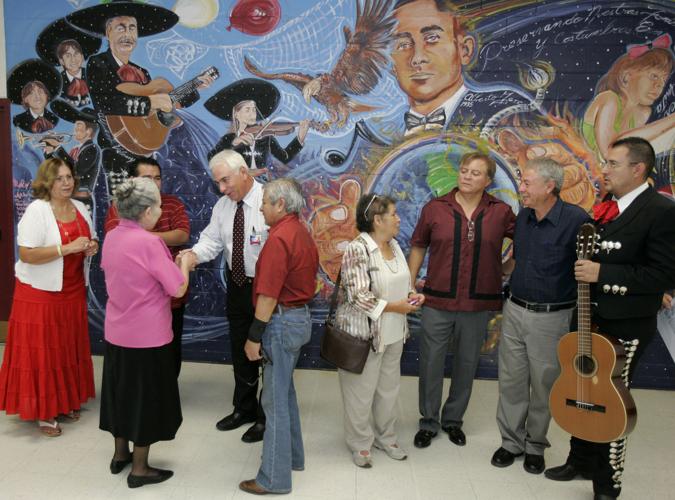You don’t have to spend much time at Davis Bilingual Elementary Magnet School to realize that it is unique among its local counterparts.
Murals, paintings and other artworks reflecting Tucson’s Mexican-American history and culture adorn the old school’s walls, inside and out.
Students carry cases containing their guitars, violins and trumpets, the integral instruments for Mariachi Las Aguilitas de Davis. A large Mexican-style jardín, with a mesquite ramada, an earthen oven surrounded by a garden of plants and trees, sits across the street from the school at West St. Mary’s Road and North Granada Avenue.
And in the classrooms, in the hallways and in the front office, Spanish is the dominant language. Sure, most of the kids jabber away in English on the playground, but inside, the school’s faculty and staff and many of the students and their parents comfortably and easily converse in Spanish. It is a sign of resistance — to the longstanding efforts in Tucson and the Southwest to erase Spanish and the rich culture that the language represents.
“There is no separation,” said school Principal Carmen Campuzano about language and culture.
I visited Campuzano in her office Friday, a day after school let out for the summer. When the students return in August, there will be a new principal. Thursday was Campuzano’s final day with her students.
“I still have energy, but it’s time to leave,” said Campuzano, who on June 30 retires after a 45-year career in public education.
It’s a career that began at Ochoa Elementary School followed by Mission View Elementary, Lynn/Urquides and C.E. Rose elementary schools on the south side, Roskruge Bilingual K-8 School on East Sixth Street, and Luz Academy, a west-side charter school. For more than half of her career, 28 years, Campuzano was a principal, the last 10 at Davis, the pride of Barrio Anita.
But in her core, she said, she thrived a teacher “in a principal’s office,” one who consistently advocated for the students, their families and their teachers.
“My job was to support the teachers in the classroom,” said Campuzano, who was born in a small town near Hermosillo, Sonora, but grew up in Tucson, graduating from Rincon High School and the University of Arizona.
Her career focused almost entirely on bilingual education, a proven teaching method that focuses on language and culture to enhance the students’ academic and personal growth.
Despite the documented achievements of bilingual education, Arizona voters in 2000 shuttered it.
“It broke my heart,” Campuzano said about the election’s result. “It was a lifetime of work. Not mine, but all the people who came before. I didn’t know if I could recover.”
She did so by leaving the district to join the college-prep Luz Academy founded by the late Pepe Barrón and by Adalberto Guerrero, two Tucson educational trailblazers who championed bilingual education. She rejuvenated her teaching spirit for the next six years as a principal and by traveling around the country visiting successful schools.
In 2008, the Davis principal’s position opened up.
It was Campuzano’s dream job to continue teaching in a school where bilingual education is sought after. Despite the 2000 law, parents can sign waivers asking for bilingual education for their children.
“When I came back to Davis, I came back with a fury,” she said.
Her fury fueled the continuation of Davis’ famed mariachi program, which was started by Alfredo Valenzuela and continues under his son, Jaime Valenzuela.
Her devotion to Davis also included commissioning local artist Luis Mena to paint two murals on the school’s walls, one that pays homage to Barrio Anita, and the second, recently completed, that pays tribute to Dolores Huerta and César Chávez, champions of labor and civil rights.
Her dedication also moved her to fight the school district’s attempt to strip Davis of its magnet-school status.
She speaks of vindication, success and respect that bilingual education brings to the school and its students.
Davis’ bilingual program acknowledges that language is culture and that the two equally co-exist.
After her four-plus decades as an educator, Campuzano said she’ll take a long, much deserved break.
But she’ll be back, she promised, maybe to work with parents and advocate for better educational opportunities.
Like bilingual education.
“After all the devastation against bilingual education, children in bilingual education programs outperform their counterparts in English-language classes,” Campuzano said.
“This is a vindication of the success of bilingual education.”





